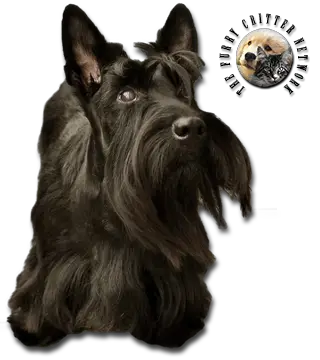Breed Standard
Head: Long. Almost flat skull. Slight stop. Solid, deep muzzle. Large nose. Thick mustache.
Ears: Small, set on high, pointed. Held erect. Covered with velvety short hair.
Eyes: Almond shape, wide set. Dark brown color. Long eyebrows.
Body: Compact. Muscular neck of moderate length. Chest is well let down. Ribs well sprung. Remarkably powerful hindquarters. Short, very muscular back. Deep, muscular loin.
Tail: Moderate length (7 in), thick at the root and tapering to the tip. Carried straight or slightly curved.
Hair: Long, rough, wiry, dense, lying close against the skin. Short, dense, soft undercoat.
Coat: Black, wheaten, or brindle of any color.
Size: 25 to 28 cm (9,8-11 in).
Weight: 8.5 to 10.5 kg (18.8-23.2 lb).
History
In 1881 the "Scottish Terrier Club of England" was founded, being the first club dedicated to the breed. The club secretary, H.J. Ludlow, is responsible for greatly popularising the breed in the southern parts of Great Britain. The "Scottish Terrier Club of Scotland" was not founded until 1888, seven years after the English club.[38] Following the formation of the English and Scottish clubs there followed several years of disagreement regarding the breed's official standard. The issue was finally settled by a revised standard in 1930, which was based on four prepotent dogs. These four dogs and their offspring modified the look of the Scottie, particularly the length of the head, closeness to the ground and the squareness of body. Their subsequent success in the show ring led to them becoming highly sought after by the British public and breeders. As such, the modified standard completely revolutionized the breed. This new standard was subsequently recognised by the Kennel Club UK circa 1930.
Scotties were introduced to America in the early 1890s, but it was not until the years between World War I and World War II that the breed became popular. The Scottish Terrier Club of America (STCA) was formed in 1900 and a standard written in 1925. The Scottish Terrier was recognized by the United Kennel Club in 1934. By 1936, Scotties were the third most popular breed in the United States. Although they did not permanently stay in fashion, they continue to enjoy a steady popularity with a large segment of the dog-owning public across the world. The STCA founded its Health Trust Fund (HTF) in 1995 which supports research on health issues in the breed.
Scottish Terriers have won best in show at the Westminster Kennel Club Dog Show more than any other breed except for the Wire Fox Terrier
Behavior
Scotties are territorial, alert, quick moving and feisty, perhaps even more so than other terrier breeds. The breed is known to be independent and self-assured, playful, intelligent, and has been nicknamed the 'Diehard' because of its rugged nature and endless determination. The "Diehard" nickname was originally given to it in the 19th century by George, the fourth Earl of Dumbarton. The Earl had a famous pack of Scottish Terriers, so brave that they were named “Diehards”. They were supposed to have inspired the name of his Regiment, The Royal Scots, "Dumbarton’s Diehards".
Scotties, while being described as very loving, have also been described as stubborn. They are sometimes described as an aloof breed, although it has been noted that they tend to be very loyal to their family and are known to attach themselves to one or two people.
It has been suggested that the Scottish Terrier can make a good watchdog due to its tendency to bark only when necessary and because it is typically reserved with strangers, although this is not always the case. They have been described as a fearless breed that may be aggressive around other dogs unless introduced at an early age.
Function
Scottish Terriers were originally bred to hunt and fight Eurasian badgers. Therefore, the Scottie is prone to dig as well as chase small mammals, such as squirrels, rats, and mice. Keeping cats, rabbits, ferrets, and other small domesticated animals in the home with a Scottish Terrier is not advisable due to the fact that this dog breed was specifically bred to hunt small mammals, as mentioned above. Scottish Terriers are also not recommended to cohabitate with small children or children who are inexperienced with dogs.
Health
Two genetic health concerns seen in the breed are von Willebrand disease (vWD) and craniomandibular osteopathy (CMO); Scottie cramp, patellar luxation and cerebellar abiotrophy are also sometimes seen in this breed. Common eye conditions seen in a variety of breeds such as cataracts and glaucoma can appear in Scotties as they age. There are no specific conditions relating the skin that affect the breed, but they can be affected by common dog related conditions such as parasites and mange. Scotties typically live from 11 to 13 years.






